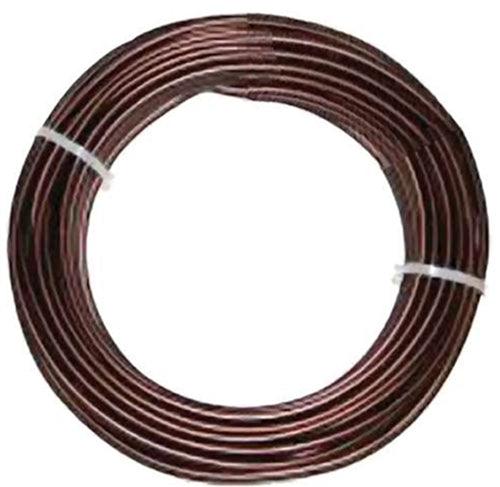Marc Noelander's Extraordinary Mountain Forest Planting
Ten years ago or so, we'd see Marc Noelanters' bonsai seemingly eveywhere, but not so much lately. Until recently that is, when I stumbled upon the extraordinary forest planting below.

Marc Noelanders' only comment with this extraordinary mountain forest planting is, "On request some pictures of a demonstration that I did a few years ago."

The trees. Marc says nothing about the type trees he used, but Cryptomeria (Japanese cedar) comes up twice in the FB comments and based on how they look in this photo, I'm on board with that.

The pot, slab, base or whatever you want to call it. There's no mention of the artist, but I think it could have been Marc.

This photo of Marc was taken at the demo.
Want more of Marc Noelander and our awesome bonsai content? Make sure to sign up for our newsletter to get it straight into your inbox.
We also have some amazing tools and resources available on our website if you really want to learn bonsai, all the way from basics to advanced design principles and techniques.
When is it Best to Repot My Bonsai?
Today's bonsai blog post, When is best to repot? Do we repot them all at once? is taken directly from Michael Hagedorn's Crataegus Bonsai blog.
All the text in italics is directly quoted from Michael and all the photos are his.

Bud swell on Hemlock, about right repotting timing

Ponderosa Pine—a bit late
When is best to repot? Do we repot them all at once?
The general guideline to repot as they break bud is a good one. Some, like pines, though, are best repotted a bit before we see bud elongation. Maples, as buds open.
If you have a long spring—one that goes on at a mild temperature for a couple months or more—then the schedule separates into phases.

Black Pine—much too late

Ezo Spruce—the tree on the right, correct repotting timing; tree on the left, too late. Tricky for this specimen as it is a forest…try to gauge by the first tree to begin moving.
A long spring schedule might look like this:
Deciduous first: Quince (Japanese and Chinese), Trident
Then, Black Pines
Satsuki, as they green up
Single flush pines, like Japanese White and Ponderosa
Spruce
Then more deciduous, like Japanese Maples, Elm
Hinoki
Beech, Hemlock
And finally, Juniper

Beech—a hair early. Beech are tricky. They are late openers, usually almost overnight. Ideally, wait for a bit of green between the bud scales to show, then repot.

Vine Maple—like many maples, they can be repotted a bit “long in the tooth”, when the buds are swelling and opening

Though Maple can be repotted with buds opening, once leaves are out it’s on the late side
If your spring is short, just a month, trees may be repotted roughly at the same time.
If repotted outside its ideal window—before or well after bud break—place the tree in shelter, preferably a greenhouse for several weeks. Greenhousing any repotted plant is a good practice for protection from wind, frost and too much rain. A common mistake is placement in too much shade after repotting. Plants need light to grow roots, and in many locations the spring sun is mild.
Looking for repotting bonsai tools? Visit our website for incredible deals on all bonsai essentials.
Pushing Bonsai Boundaries with Peter Steven
There are always those pioneers who push the boundaries of any type art. Sometimes to the breaking point. Robert Steven is one of those pioneers and whether or not you like the results, my best guess is that, at the very least, your mind will be stopped for a moment or two.
This one and the two just below are from a show last summer Robert Steven created using his own mixed media bonsai. With a little help from his friends of course.

I like the story that this one tells. And the scale.

Hmmm. Unusual to say the least. Here's a quote by Robert that might go with this one. "Bonsai elites are those unconscious incompetence in bonsai, but you are idiotically fawning for their narcissism in cutting ribbons rather than how to handle bonsai tools " A little harsh for my taste, but given what Robert has accomplished over the years, maybe he's earned a pass.
For more boundary breaking bonsai artwork, sign up for my newsletter where you can get beautiful art straight to your inbox! Also don't forget that we have a Big Spring Sale, with 40% to 60% off on approx 200 products. Everything else is 10% to 40% off!
Making Bonsai Pancakes with Peter Tea
If you don't know Peter, one of our most accomplished young bonsai artists, you're in for a treat. And if you do know Peter, you're still in for a treat.
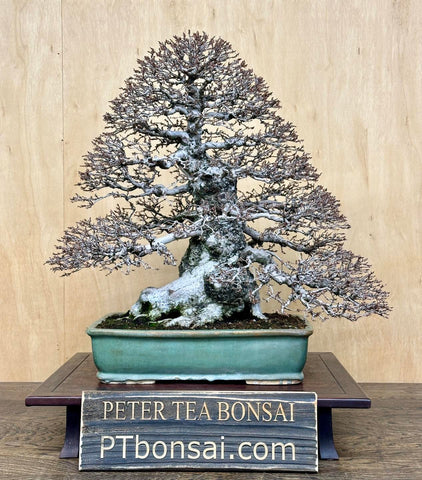
One thing that jumps out for me with this remarkable tree, is the well developed ramification all the way out to the tips of the twigs. Here's Peter Tea's caption, "The deciduous work begins! Defoliated this Korean Hornbeam and a slight thinning and cut back."
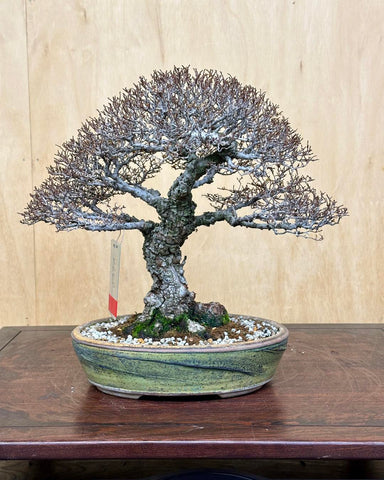
Another one with good ramification. Here's Peter's caption, "Ramified Seiju Elm in a Sara Rayner pot! It’s going to get a repot in February."
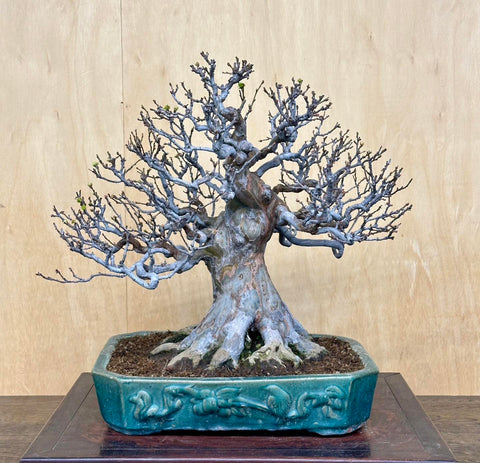
Here's what Peter wrote about this tree, "Chinese quince getting more refined! The roots are also starting to fuse and we’ll show more of that in the next repotting. Graft I did in early 2023 up top is growing and looking forward to fill the hole there. Pacific Bonsai Expo 202?"
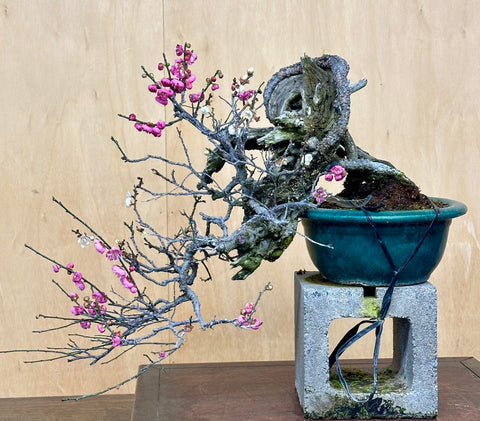
I'm looking forward to seeing this tree in few years after Peter has worked some of his magic. Here's what he has to say about it, "Japanese flowering apricot is blooming at the garden! We’re going to graft a few branches closer to the interior in March and dense this guy up!"

We'll let Peter do the talking, "Eli, Max and myself headed down to the Bonsai Garden in Lake Merritt and repotted this 1500+ year old California Juniper. It took three of us to lift the tree out of the pot and we were able to get the tree into a smaller oval pot."
By the way, Lake Merritt in Oakland CA is the home of the Golden State Bonsai Federation's bonsai garden.

Here's Peter's story with one, "Eli and I making some pancakes! Repotted a number of Black pines in big nursery containers. Whipped out the Sawzall to take slices of the rootball away to save time. Once we got close to the roots we planned to keep, we went at it with hand tools."

Peter's caption for this one, I purchased this Seiju elm back in 2017 at an auction and the first thing I did was cut all the branches to stubs and repotted it into a smaller pot. I did this because the branches were very leggy and pot was huge! After a few years of branch development I sold it to a client of mine and has been under his care for the last 5 years. He has since decided to downsize his collection and now the Elm has retuned to the garden! The tree is now just starting to bud out due to warm days in Sacramento last week. I plan to continue its branch development and hope to show it in the future! 🤩
The tree stand right at 17inches tall."

One more by Peter and it's a doozy. Here's what he wrote, "Rebuilding this funky little Black Pine! Looking forward to a good 2024 and the continued refinement of this tree.
"I feel like I should give this tree a name. What do you think?"
Sources:
Peter Tea on FB
Peter's website
GSBS Bonsai Garden at Lake Merritt
Peter Tea on Bonsai Bark
Our Three Favorite Photos from UBE Expo in Madrid
Michael Hagedorn, a highly respected American bonsai artist and author of Bonsai Heresy and Post Dated, just posted some excellent photos he took at the recent UBE Expo in Madrid. I've picked three of my favorites. I hope you enjoy them as much as I do.

Itoigawa juniper. There's a lot going on here, with such a wild, free play of fluid movement. I think the artist was fearless, not to mention skilled, when he or she set about to transform so much living tissue into dead wood.

This one, which Michael calls simply Chinese juniper, is another tree where the deadwood demands our attention..

Aha. Bunjin. Please correct me if I'm wrong, but I don't think you see that many great bunjin (literati) style trees outside of Asia. I like both the fine deadwood touches as well as the way the whole tree hangs together, with the downward sweep of the branches and trunk's strong upward movement (at times like this, I wish I were a poet).
Michael's books are here and links to Michael's site and blog are below.
Sources:
Michael Hagedorn's Crataegus Bonsai site
Michael's blog
Michael on Bonsai Bark
Bonsai Roundup with Bonsai Mirai, Eric Schrader and more
We've got a New Bonsai Roundup for you today. Enjoy!

We found this sterling Silver Fir at Bonsai Mirai. Here is their description:
Pacific Coastline - age: 100-250 Years - size: Large - collector: Jason Eider - potter: Byron Myrick - initial creator: Eric Shikowski - availability: Private Collection.

This magnificent Coastal redwood in an upright weeping style was styled by Eric Schrader. We found in on FB at Bonsai Society.

I've seen full grown Acacia along some highways in costal California, but I don't think I've ever seen one quite like this. It was posted by Pete Inglis on FB. Here's what he had say about it: "Friday night Bonsai. It's been a while. Acacia Howitti, Sticky Wattle. Imported Chinese pot. Loving the early spring weather."

Here's a highly stylized Moss cypress by Peter Tea. And here's what Peter wrote about it: "The yearly cut back and thinning of this Moss Cypress has occurred! Tedious work but well worth it. We’re planning on repotting to tree into a different pot next Spring."

Another one from Peter Tea. "2nd defoliation for this root over rock Trident Maple. Most of the time I defoliate this tree twice a year though sometimes just once depending on the strength of the tree that year. It’s nice seeing the Winter silhouette in the middle of Summer."

This one was posted by 鳳鳴盆栽 on FB, and here's their comment:
"For all of you "WTF"? It may be considered "imitation", but it is a treasure to me. I've gotten much better after a couple of years since I was shaking. I love the shape of this tree 🤣 cleaned and measured. Fall leaves are just around the corner. My energy is number one 👍"

Another one by 鳳鳴盆栽. Are you detecting a pattern?

The other side.

Here's another one from Bonsai Mirai. This time from FB. It's about their Summer Tree Mercantile.
Gallery Sources:
Bonsai Mirai website
Bonsai Society on FB
Bonsai Barn on FB
Pete Inglis on FB
Peter Tea on FB
鳳鳴盆栽 on FB
Bonsai Mirai on FB
2023 8th U.S. National Bonsai Exhibition
Bonsai - Rough and Ready
We've got some rough and ready bonsai and some others that are a bit more elegant. All by Walter Pall.

I love everything about this tree. The lovely spring leaves, the pleasing shape of the crown, the profusion of rugged and distinctive trunks and and visible lower branches. And of course the powerful nebari. Here's Walter Pall's caption, "Japanese maple #30. About 65 cm high (26"). Pot by Walter Venne. Tree is originally from a cutting in a nursery in South Korea. It was imported to Germany in May, 2021."
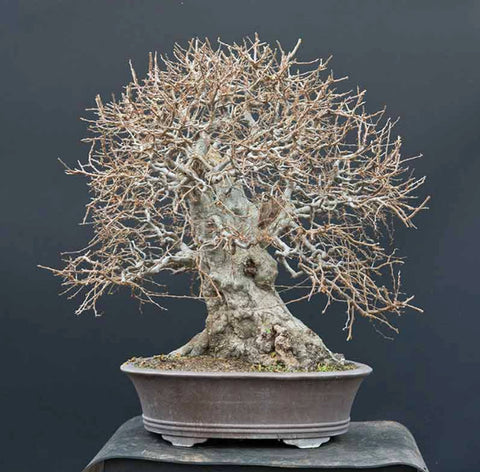
Here's a beefy Oriental hornbeam by Walter. No leaves so you can see the profusion of small branches and twigs. This wild natural look is one of Walter's trademarks.

Another Oriental hornbeam, but with leaves and a bit more pleasing to the eye. What a difference a few months make.

Another rough and ready hornbeam. But this time a cascade.

Aha, a little less rugged and a lot more elegant. It's Walter's Trident maple #11. About 50 cm high (20"). Pot by Walter Venne. The tree was imported from Japan in 2001 and was styled by Jurg Staheli of Switzerland until Sept 2019 and then by Walter.

Another colorful Japanese maple. It's Walter's #17. height 40 cm (16"). Pot by Walter Venne. Tree originally imported from Korea.
Sources:
Walter Pall's Bonsai Adventures blog
Walter Pall Bonsai Bark Archives
Walter Pall on FB
Bonsai Roundup with David Benavente, Francesco Santini, Ed Trout and more
We've rounded up a few trees by various artists for your viewing pleasure and hopefully inspiration. If you'd like to explore any on your own, there are links way below.

David Benavente seems to present an endless train of brilliant bonsai. Most set in his perfect (yet relaxed) Bonsai Studio garden wonderland.

Another one from David Benavente. Here's the caption, "New available. Wild olive, wild bonsai. Just restyled by Pablo Comesaña."

Here's one that was posted by Moyogi Chris at the Bonsai Club Eda Uchi Kai on FB. Here's the caption, "A species not seen every day as a bonsai, this Potentilla fruticosa. But this specific tree from one of our club members, as shown during our recent exhibition, is not only extremely well developed, the tree/pot combination is just as stunning as well. Sometimes good things come together ...."

After and Before. Itoigawa Juniperus chinensis by Francesco Santini.


Pinus parviflora by Francesco Santini.

This one was posted by Kuanghua Hsiao. Here's the caption, 分享自 Komunitas Bonsai 的的相片。And here's the machine translation, Shared photo from Komunitas Bonsai.

Here are a couple crazy Buttonwoods by Ed Trout who lives in Florida.

Here's Ed's caption. "I grew up climbing Buttonwoods during my youth in the Florida Keys. I clearly remember the odd shapes of these incredible trees, and how beautiful they are as giant specimans. The “crazy” ones stuck in my brain, so that’s probably why I style many of my trees in those contorted shapes. Not sure if the shapes are crazy, or it’s me that’s crazy 😂? Then again maybe I do know…."

And finally a Bougainvillea, also by Ed Trout.
Sources:
David Benavente on FB
Myogi Chris on FB
Eda Uchi Kai on FB
Francesco Santini on FB
Kuanghua Hsiao on FB
Ed Trout on FB
Ed Trout on Bonsai Bark
Seasonal Bonsai Trimming with Michael Roberts

We're featuring just one tree again today. It belongs to Michael Roberts, a Southern California bonsai artist. Here's Michael's caption, "30+ year old twin trunk Cork Bark Elm prepped for the Baikoen “winter Silhouettes” show this January 13th & 14th from 10-5 at the Los Angeles Arboretum. Hope to see you all there."

Before and after trimming from back in August when it had leaves. You might notice how much light comes through in the after shot. John Naka's axiom about enough space for the birds to fly though was well heeded.
Sources:
Michael Roberts on FB
Bonsai Bark
Simple Bonsai Beauty by Mark Arpag
We've got a four photos today from American bonsai artist Mark Arpag. I hope you enjoy them as much as I do.

Chojubai dwarf flowering quince by Mark Arpag.

I know this Beech belongs to Mark Arpag and that I got it on FB, but now I can't find what Mark wrote with it. Anyway, I like its natural feel and simple beauty.

Mark doesn't mention the variety, but he did offer this message on Dec 25th.
Peace, Joy & Harmony
Today & every day
Merry Christmas
I guess we're a little late with this, but it's a lovely photo and the sentiments in the first two lines could extend beyond the holidays.

One more by Mark Arpag.
Sources:
Mark Arpag on FB
Mark on Bonsai Bark

